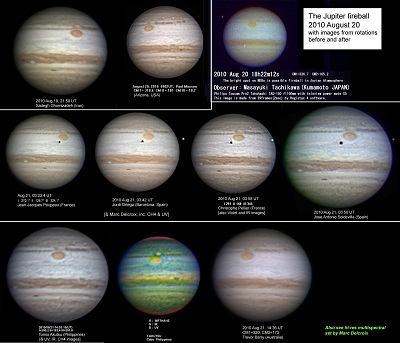
[7] ANOTHER BRIGHT FIREBALL ON JUPITER (Aug 22, 2010)
Another fireball has been reported on Jupiter: this one by Masayuki Tachikawa in Kumamoto city, Japan. He recorded a bright flash on the NEBn (L2 = 140, lat. 21 deg.N), at Aug 20d 18h 22m UT. His video is viewable at:
http://libra-co.com/Jupiter2010Aug20182212UT.wmv
The fireball was confirmed in simultaneous recordings by two other Japanese observers: Kazuo Aoki and Masayuki Ichimaru. See, for instance:
http://www.planetary.org/blog/article/00002633/
As on 2010 June 3, this fireball did not produce any visible mark. Attached are the hi-res images taken 1-2 rotations before the event by Sadegh Ghomizadeh (Iran) and Paul Maxson (Arizona), and 1-2 rotations after the event by observers in France, Spain, the Philippines and Australia. As the observers commented, there was no visible mark (not in RGB, nor UV, nor methane). Dark brown spots on NEBn were already there before the fireball.
An excellent set of images one rotation after the event has also been posted by Marc Delcroix, in a full range of wavebands including the methane band, confirming that the fireball left no mark. This and other image sets are on the ALPO-Japan web site at:
http://alpo-j.asahikawa-med.ac.jp/kk10/j100821z.htm
It would really be worth determining the frequency of these events. Some ideas:
1) Regular observers: Please can you tell me: On a typical night, how many minutes of video do you record and look through?
2) From now on, could regular observers record the start and end times of video they view each night, and could anyone volunteer to collect this information? Perhaps regional associations (ALPO, ALPO-Japan, etc.) might be able to collect this info? I hope this would not be a burden for observers -- Obviously it is wonderful when you process and send the best of your images as soon as possible, and I certainly would not ask you to delay until you have completed the paperwork! A list of video times sent once a month would be fine. But it would be worthwhile, so the amateur observersí network could get an important measurement of the frequency of these events
3) Maybe someone could devise software for scanning the webcam videos and identifying these fireballs automatically??
John Rogers
BAA Jupiter Section Director
Click for full size image.